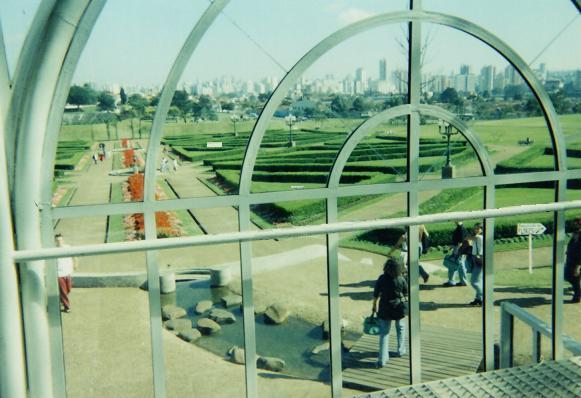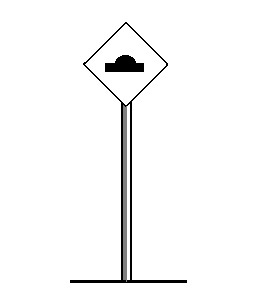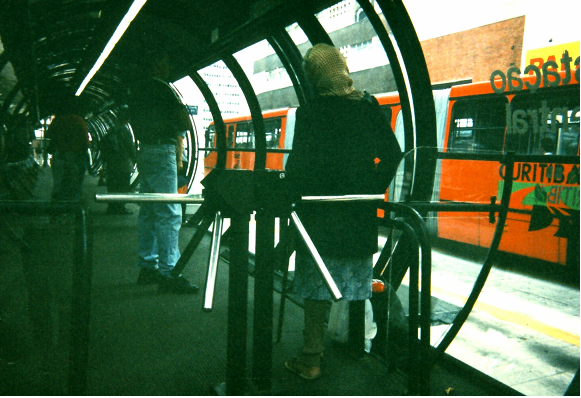I also took my daughter there to show her how to get a ticket, as she will take this same bus when she goes to Canada for her home stay near future. As for her, this will be her first trip abroad. About a month ago, she went with me to the J.T.B.'s office in Ikebukuro to hear about home stay programs. She is studying English literature and wants many chances to speak English. Just last night, she received a letter and photo from her home stay family. It was of a young husband, a pretty wife and their three small children. I wrote their address down in my address book, so, after that, I could send a letter from Brazil to my daughter in Canada.
The bus stop for Narita Airport was near to the one which I often use after returning from a domestic trip. I got on an express bus for Narita Airport. At Narita Airport, I talked on the phone 'goodbye' to my son who already graduated and working. Then, just little bit tense, we together with my colleague left Narita. It took 28 hours to fly to Curitiba in Brazil.
After we arrived at Curitiba, at 11:00 a.m., Mr. Bruno, who is our partner, and his wife kindly took us on a city tour. He drove counterclockwise around the city giving us a very detailed commentary. We could see the Botanic Garden which was located a bit far from the tall buildings, the State Museum and the shopping center. We then went to have lunch at one of the restaurants on Rua Manoel Ribas which is located to the north-west of the city. "Rua" means a street in Portuguese. We ate Brazilian food. We finally were very much tired.

−・−
In Curitiba, I had surely my first experience in southern Brazil. In the restaurant, the dishes were the nicest looking that I had ever seen. It was my first time to have seen such a style of serving food. In Portuguese, it was called Churrasco. First of all, a waiter, who could not speak English, come up to our table holding a big piece of meat on a large spit in his left hand, and in his right hand holding a plate and a knife. He then put the plate near the center on the table, then, immediately put the bottom end of the spit on top of the plate. He then held the spit of meat in an upright position. Next he looked toward me and with his knife pointing at the well-done meat, asked me which part of the meat on the spit I would like. Many waiters like him often came up to our table during our meal. During the meal we talked mostly about that day's nice motion of them.
There seemed to be a lot of customers in the restaurant even after 2:00 p.m. Whenever someone came and joined them, they said "Todos bons?" meaning, "Are you fine?" And they always embraced each other. We each had a glass of cerveja beer, called Antarctica, when we started our meal and then we tried a glass of Caipirinha. Caipirinha was a sweet alcoholic drink made from sugar cane and an alcohol called Pinga. I became to like it by the time I left Brazil.
We had started our city tour again near Curitiba Airport after lunch. Leaving the airport, we had to slow down to pass over a Lombada-speed bump-which was built across the road as a projection to prevent traffic accidents. After that, we passed over many, many Lombadas which were located not only on big roads, but also on small alleys in the city. Also, there was always a road sign about 100 or 200 meters before a Lombada. The road sings were shaped like a yellow diamond. At the center of the roads signs there were, so to speak, a thick chopping board with a big egg yolk on top of it, both of them colored black. We could also easily understand that the signs are indicating a Lombada as there is also written on them in big capital letters LOMBADA. It wasn't later, when we were in Belem, that Mr. Nelson suggested that the pronunciation of Lombada should have the accent on the first syllable. I gave some thought as to why there were so many Lombadas in Brazil. It's probably because Brazil is such a specious land and people want to drive fast in their cars. Someone, who had been Indonesia before, told me that Indonesia also had Lombadas.

It was about 4:00 p.m. when we at least arrived at our hotel. The hotel was located on Rua Benjamin Constant near the center of the city. Standing at the entrance of the hotel facing the street, the street was one way from right to left. The street was very tranquil. The surface of the sidewalk was made out of a lot of light gray unevenly shaped stones about the size of a CD case. In Brazil, we walked on many sidewalks like that. I think it was maybe because they could easily find such stones near the town. From a distance the sidewalk looked nice, even though up close the sidewalk didn't look so good and was hard to walk on. Before going into the hotel, Mr. Bruno kindly gave us three bottles of local wine. A bellboy nearly dropped my luggage from the trunk of our car, because my luggage was large and unwieldy.
Mr. Bruno then took us into the hotel. There are usually only one or two staff members who can speak English in such kind of hotels. I needed to know how to say my room number 702 in Portuguese just to make sure. My room number was sete zero dois in Portuguese. Before Mr. Bruno left us at the hotel, he showed me the way to the nearest busy street two blocks away from the hotel. We were going to have dinner somewhere there after taking a shower. We said thank you to his wife and him and then went up by the elevator to our rooms with a bellboy carrying our luggage. We saw some colorful notices in the elevator. One of them showed that there was a pool on the top floor. It was not on the rooftop, as I imagined it would be. The elevator slowly reached the 7th floor where my room was. The sliding door of the elevator opened and I tried to step out of the elevator, but the bellboy's right hand made me stop. This was because there was also a swinging door. We had to push the door open by ourselves. It was unique for me.
My hotel room had a separate bedroom and a big living room. Stepping through the entrance door, there was a big living space with a three-person sofa at the other end of the room. Behind the sofa there was a white wall dividing the living room from the bedroom. Opposite the sofa there was a TV set which had a 99 channel switch. To the left of the TV there was a square table where I put the three bottles of wine, which Mr. Bruno had given us. There was also a window between the sofa and the TV set. Looking through the window, I saw colorful western-style houses behind the tall buildings which I have mentioned about before. In front of the tall buildings, many European-looking Brazilians were walking, or riding a bus, along the street in the early evening. It seemed to me that Brazilians, at least those living in Curitiba, looked very much like Europeans. Almost all the people seemed to me to have European features, but they were not so big like Americans. I felt an illusion, as if I were in Europe.

It had been mostly cloudy since I had arrived there. The weather in Curitiba was similar to the early fall weather in Japan. It was the middle of February, whereas, it must still have been cold in Japan. One night, when I watched TV in my hotel room, CNN News reported a tunnel accident in Hokkaido. I could see on T.V. that beside the entrance to the tunnel there was a lot of snow covering the bare trees. Compared with such winter weather in Hokkaido, Curitiba had a nice climate in which to live. Curitiba is located in Parana State, which is in the southern part of Brazil next to Paraguay. That area was nearly the other side of the world from Japan, I guessed. Therefore, at that time, I was upside-down when standing or sitting, as compared to my family's position back in Japan.
−・−
I could begin to experience standing or sitting, in Southern Brazil like this upside-down!
"Return to Homepage"